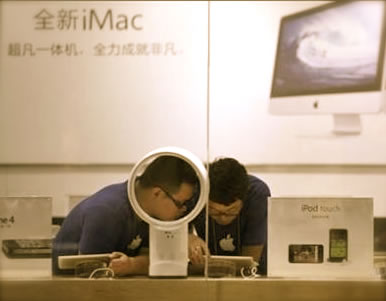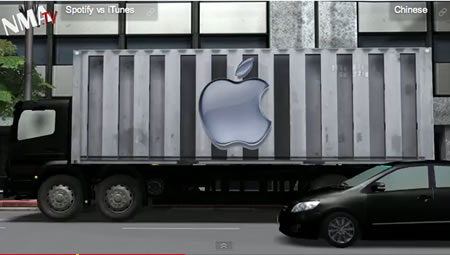
Workers at a fake Apple store with an iPad tablet in Kunming, Yunnan province, on Friday.
Wong Campion / Reuters
The Soul of the Brand Material
In the emerging wild east of China, the idea of counterfeiting continues as the savaging of anything and everything duplicable.
In a way, it might be said that this sense of duplication is the legacy of the vast machine that is China, that focuses on remaking everything — in extraordinary numbers. That might be commissioned, that might be self generated, that might be pirated merchandise. So the idea of remaking stores, building their own sales from the mystically imaginative smoke of concept and ideation, and simply duplicating it, falls right in line with that heritage. Get a prototype and “make” it. Why not retail holism? Get a prototypical store concept, discover the code, remake it, and build it. And, they will come — supposedly.
They are copiers, one might ascertain. In the heritage of the China, historically, the grand lineage of trade, copying, duplicating, lies in the heart of commerce. Make one, make many. Make money. But, there might be a challenge — customers in one store, located in Kumming, have returned in anger, saying they were misled, demanding their money back.
There is a soul link, to the finding of space and the place-making of retail environment. It’s been pointed out that even though these stores try to duplicate the stores and their products, they aren’t necessarily believable; things don’t feel right. Though, by some, the store is called “pretty close to the real thing.” What’s missing then? Truth, for one. Vibe, another — the integration of intention (forward focus) and holistic vision. Retail “pirates” can’t copy everything — there will always be something missing.
Therein, the soul of placemaking and the magic of the touch of how things feel — including the employees that work there; is the brand story aligned, is the character of the place tuned into the central visioning.
But, the copy has a legacy. That idea is relatively ancient: copy. It’s a word that’s Latin — copia, which in turn links to “copious.” That idea of copying is about transcription — from the later Medieval Latin, copiare, “to write in plenty.” Copycat is American, from the late 1800s — and later, in US parlance, as a verb — from 1932; to “copy+right” is the right to make and sell copies, as a verb — 1806. And to replicate (as a reply) almost speaks to a Chinese response — ask the question, “could it be done,” and it might be implied that the answer is “yes.”
You make. It can be copied. Apple makes, and one of their key cultural partners can make it. This will be challenged. One copy can surely beget another.
As a designer, moving from the non-digital to the digital age, from the live painted brush and scribing pen, film in the camera and negative burning the metal plates for printing — things change; it’s possible for anything to be copied. In working with a designer in Korea, corresponding, it was possible for him to move online, and gather texts, pictures, illustrations and reframe them all in another article. All, really, in barely communicating with me. Files can be duplicated, illustrations can be copied, manipulated and retooled — in the hands of one, and then in the digitized hands of others; textures gathered online, photographs can be photographed — one copy, another made. It’s the age of copying.
It might be noted that, in the end, reality pays, authenticity energizes — people relate to — and celebrate — the legendary real over the falsely defined.
In Shanghai, with the power of two monster stores, perpetually packed with Chinese customers — many of whom aspire to the newest versioning of Apple whatever — committed, waiting product sentinels, Apple is now considering building a store of even greater magnitude there. Two stores in Beijing and two stores in Shanghai — these four are the top ranked Apple stores, by volume, in the world. Building more — plus, likely dozens of others in an environment that now represents the number one market in the world. These stores, representing sales toppling the dollars per square feet of the prized 5th Avenue / Central Park South glass cube, (whose numbers surpass the baseline for a luxury retail showing.)
Tim | Santa Barbara
….
GIRVIN | Brands that are built on truth
EXPERIENCE DESIGN | THE STRATEGY OF MEMORY
the reels:http://www.youtube.com/user/GIRVIN888
girvin blogs:
http://blog.girvin.com/
https://tim.girvin.com/index.php
girvin profiles and communities:
TED: http://www.ted.com/index.php/profiles/view/id/825
Behance: http://www.behance.net/GIRVIN-Branding
Flickr: http://www.flickr.com/photos/tgirvin/
Alltop network: http://my.alltop.com/TGirvin
Google: http://www.google.com/profiles/timgirvin
LinkedIn: http://www.linkedin.com/in/timgirvin
Facebook: http://www.facebook.com/tim.girvin
Facebook Page: http://www.facebook.com/girvindesign
